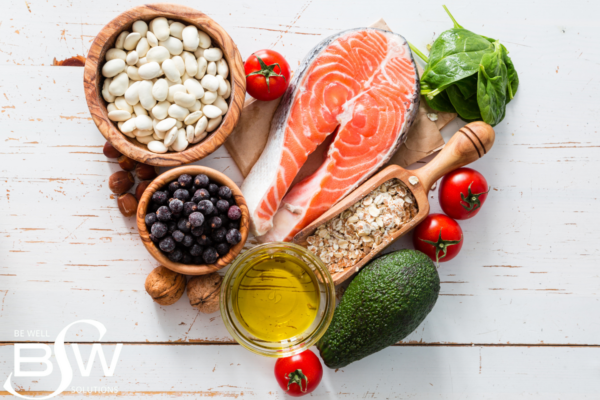February is American Heart Health Month, a time dedicated to raising awareness about the nation’s leading killer, and to remind our friends and loved ones that heart disease can be prevented 80% of the time! Heart Month is a great time to focus on steps we can take to keep our hearts healthy and strong. Often, these steps emphasize exercise, proper sleep, stress management, and nutritional strategies.
Our diet plays a big role in reducing risk. One of the best strategies is to incorporate healthy fats—particularly the omega-3 fatty acids found in fatty fish— into our meals. The special fats found in fish such as salmon, tuna, mackerel, sardines, and herring support health and healing of the cardiovascular system, as well as other bodily systems.
Why Fatty Fish are Essential
Dietitians and other health scientists refer to nutrients as “essential” when our body is unable to produce them. These nutrients must be supplied through dietary sources. Beyond high-quality protein, fatty fish are a prime source of essential fatty acids. These fats help reduce the risk of heart disease, promote healthy brain function, and may even improve mood. While fish such as salmon and tuna are often the stars of many health-conscious diets, other more budget-friendly options—sardines, mackerel, or anchovies—also deliver a similar omega-3 punch.
Cooking Techniques to Enhance Flavor and Appeal
One common hesitation people have about fatty fish is the “fishy” taste or concern over texture. However, the right cooking techniques can unlock a range of delicious flavors:
- Baking and Roasting: Place fish fillets on a sheet pan, drizzle with olive oil, sprinkle with herbs or spices, and roast at 400°F (200°C) for 10–15 minutes, depending on thickness. This method yields a moist interior and crisp edges.
- Grilling: Marinate fish in a mixture of citrus juice (like lemon or lime), garlic, and heart-healthy olive oil for 15–20 minutes, then grill over medium heat. The quick cooking time of fish makes it easy to avoid overcooking, and grilling adds a smoky flavor.
- Poaching: Simmering fish in a shallow bath of water, vegetable broth, or white wine keeps it exceptionally tender. Add aromatic herbs, peppercorns, and bay leaves for gentle, subtle flavors.
- Pan-Searing: Coat a hot skillet with a small amount of oil, place the fillet skin-side down (if applicable), and cook until the skin is crisp, and the flesh easily flakes. This technique offers a restaurant-quality finish at home.
To add appeal, pair your fish with bright sauces or dressings, such as a tangy lemon-caper sauce or fresh herb chimichurri. The acidity of citrus juices or vinegars complements the richness of fatty fish. Many people enjoy low-fat mayonnaise-based alternatives. For more saucy ideas, check out allrecipes.com.[1]
The other common objection to fish is the lingering odor that stays around after the meal. The odor is disagreeable to most humans and is due to a chemical called trimethylamine (TMA). The staff of the Black Marlin Bayside Grill have offered 14 great suggestions to combat TMA-generated odors. Check them out, here.[2]
Budget-Friendly Strategies
While certain fish can be pricey, there are plenty of ways to enjoy the nutritional benefits without breaking the bank:
- Canned Fish: Canned salmon, sardines, tuna or mackerel are often significantly cheaper than their fresh or frozen counterparts. They work well in salads, sandwiches, or added to pasta dishes.
- Frozen Options: Opt for frozen fish fillets when on sale. Proper freezing techniques maintain quality, and fillets can be thawed gradually overnight in the refrigerator.
- Local Markets and Sales: Keep an eye out for sales or discounts at local grocery stores or fish markets. Buying in bulk can also reduce overall costs—just be sure to freeze portions properly for future meals.
Should You Supplement?
If you struggle to eat the recommended two servings of fatty fish per week, omega-3 supplements could help fill the gap. Fish oil capsules or algae-based supplements (suitable for those who prefer a plant-derived source) are common options. Remember, it’s always best to speak with a healthcare professional before starting any supplement regimen, as individual needs and health conditions vary. Certain populations may benefit more from supplementation than others – your doctor can help you decide.
Small Changes, Big Impact
Incorporating healthy fats into your diet is a powerful way to support a healthy heart. By exploring diverse cooking methods, experimenting with flavor-boosting marinades and sauces, and using money-saving techniques, you can easily make fatty fish a regular and enjoyable part of your meal plan. Whether through fresh fillets, canned options, or thoughtfully chosen supplements, these choices can help you stay heart-healthy not just in February, but all year long.
Continue Reading February 2025 Newsletter: 7 Lifestyle Changes for Cardiovascular Health

